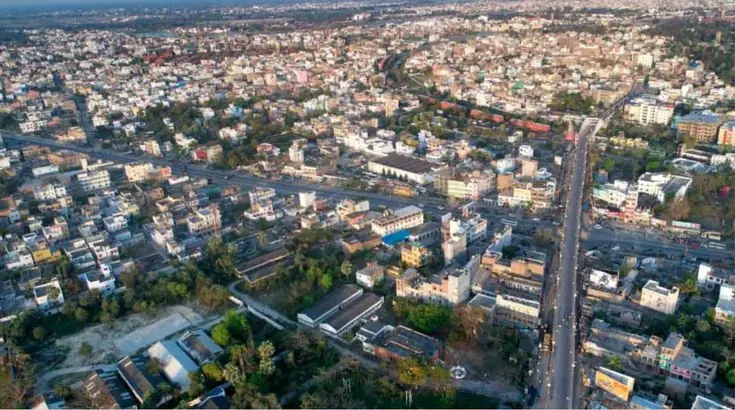
Muzaffarpur is a storied riverine town in Bihar, popularly known as the “Land of Lychee.”
Muzaffarpur’s essence and setting
Muzaffarpur lies to the north of Patna, set along the Burhi Gandak River and flanked by other watercourses that nourish its lush lychee orchards. The city functions as the administrative hub of Muzaffarpur district and acts as a commercial and educational nucleus in north Bihar. Its name commemorates Muzaffar Khan, a British-era revenue officer, linking its modern identity to a colonial-era administrative lineage. The surrounding region blends Mithila heritage with Buddhist, Hindu, and Muslim cultural influences, creating a cosmopolitan microcosm in rural Bihar. This confluence surfaces in language use, religious sites, and a distinctive regional cuisine that still celebrates local lychees as a symbol of economic pride. These facets make Muzaffarpur a microcosm of Bihar’s broader historical currents and contemporary life.
Historical arc: from ancient republics to a trading hub
Muzaffarpur’s historical footprint stretches back to ancient times, with regional power dynamics shaped by the Vrijji (Licchavi) confederation that once dominated Vaishali and the Mithilā region. The Licchavis are repeatedly cited as a central force in early northern Indian political life, and alliances with larger powers like Magadh underscore Muzaffarpur’s role as a borderland where Hindu and Islamic cultures intersect. Across subsequent centuries, Muzaffarpur witnessed the passage of dynasties and empires, and by medieval times it had become a crossroads of trade, culture, and religious life. The district’s modern administrative identity was formalized in the late 19th century under British rule, with Muzaffarpur emerging as a municipal center in the 1860s and later as a district headquarters. This layering of history helps explain Muzaffarpur’s enduring relevance as a cultural and political hinge in Bihar.
Lychee, markets, and cultural life
Muzaffarpur’s fame as the “Lychee Kingdom” is not merely agricultural; it is embedded in the city’s seasonal rhythms and trade networks. Lychee cultivation and associated horticulture have shaped local labor patterns, market dynamics, and even festival calendars. The city’s markets—especially Motijheel’s bustling precincts—provide a window into daily life, from traditional cloth and handicraft stalls to modern retail experiences. Culinary traditions in Muzaffarpur fuse Mithila flavors with North Indian influences, yielding dishes like Ghugni, Litti, Dhuska, Kadhi Bari, and Pittha, which locals and visitors savor in eateries and roadside shacks alike. This gastronomic identity complements the region’s religious and architectural landmarks, creating a layered traveler experience.
Key sites and experiences for visitors
- Garib Sthan Mandir: A revered temple that draws devotees and curious travelers alike, reflecting the devotional dimensions of Muzaffarpur’s religious landscape.
Jubba Sahni Park: A green, family-friendly park named after a notable freedom fighter, offering respite from the city’s bustle and a canvas for local history enthusiasts.
Ramchandra Shahi Museum: A repository of regional artifacts, paintings, and sculptures that narrate Muzaffarpur’s cultural evolution and its connections to broader Mithila art and history.
Devi Mandir: A sacred site dedicated to the Mother Goddess, contributing to Muzaffarpur’s status as a spiritual hub within the Mithilanchal belt.
Motijheel: The city’s principal commercial heart, where daily life, commerce, and social exchange converge, making it essential for visitors who want to feel the city’s pulse.
Khudiram Bose Memorial: A tribute to the revolutionary figure linked to the Freedom Struggle, reflecting Muzaffarpur’s contribution to India’s political history.
Litchi Gardens: The agricultural heart of Muzaffarpur’s identity, where visitors can observe harvest cycles, learn about orchard management, and savor fresh lychees when in season.
Cultural synthesis and regional identity
Muzaffarpur’s cultural fabric is a mosaic of Hindu, Muslim, and Nepali influences, shaped by its strategic position near the Mithila region and its historical role as a trading hub. The city’s linguistic landscape reflects this blend, with Vajjika (a local language) commonly used in daily life and broader Hindi serving official functions. The area’s religious architecture and festival calendars showcase interwoven traditions, reinforcing Muzaffarpur’s reputation as a place where ideas, faiths, and cuisines mingle in daily practice. This synthesis makes Muzaffarpur a compelling case study in Bihar’s regional diversity.
Practical travel notes
- Best time to visit: The Lychee harvest season (summer to early monsoon) is a peak draw, coupled with spring and autumn cultural events and temple fairs that offer insight into local life.
- Getting there: Muzaffarpur is a transportation hub in north Bihar, with roads and rail links facilitating access from Patna and other major Indian cities. Local travel arrangements typically include auto-rickshaws, cycle rickshaws, and short-distance taxis for urban exploration, with larger excursions organized through local guides or hotel concierges.
Getting around: Within the city, compact neighborhoods and markets are easily walkable or reachable by short rides, enabling visitors to experience street life, temple precincts, and parks at a relaxed pace.
Why Muzaffarpur matters today
Beyond its historical aura, Muzaffarpur remains an active center of commerce, culture, and education in Bihar. Its lychee industry continues to contribute to regional branding and export-oriented agriculture, while its museums and parks preserve and present the district’s stories to both residents and visitors. As a gateway to Mithilanchal’s traditions, Muzaffarpur offers a accessible lens into Bihar’s past and present—a place where farmers, traders, historians, and travelers intersect in a shared civic space.
If planning a visit, consider aligning travel with local markets and lychee harvests, and reserve time for the Ramchandra Shahi Museum, Jubba Sahni Park, and Garib Sthan Mandir to experience Muzaffarpur’s multifaceted character. This city’s enduring appeal lies in its ability to fuse agricultural bounty, historical depth, and everyday Bihar’s vibrant living culture into a single, memorable journ
